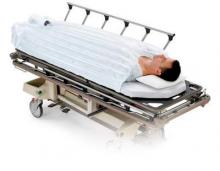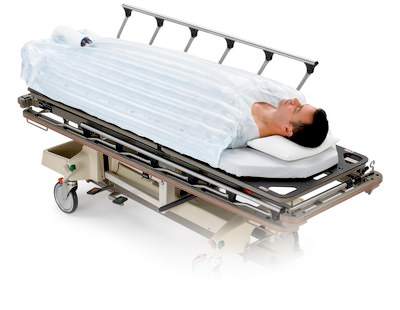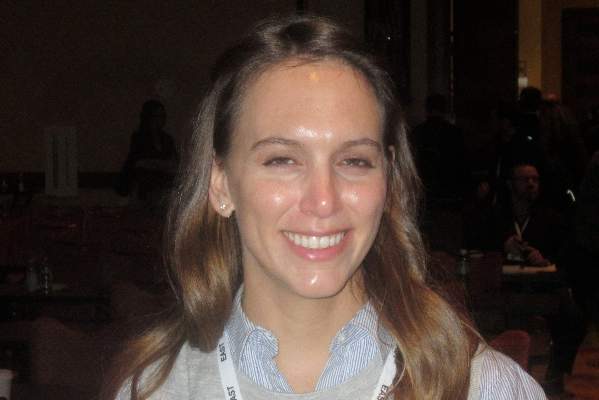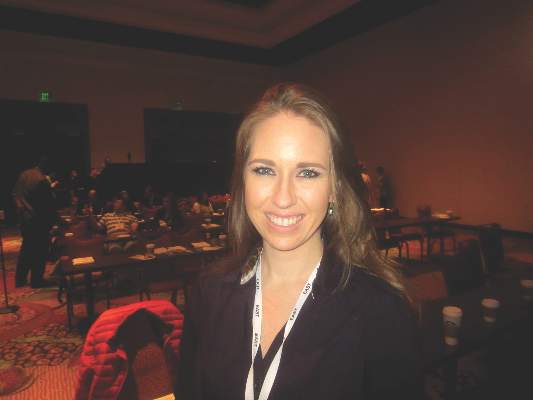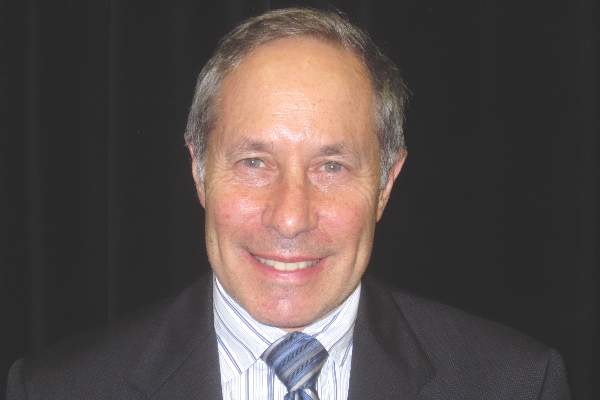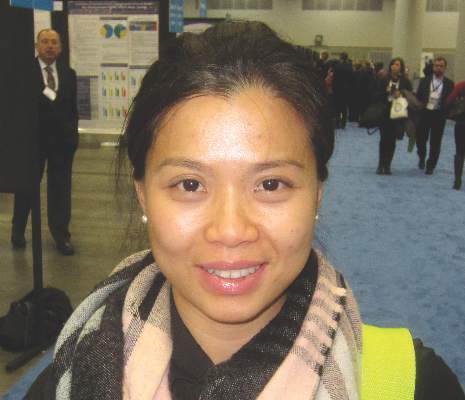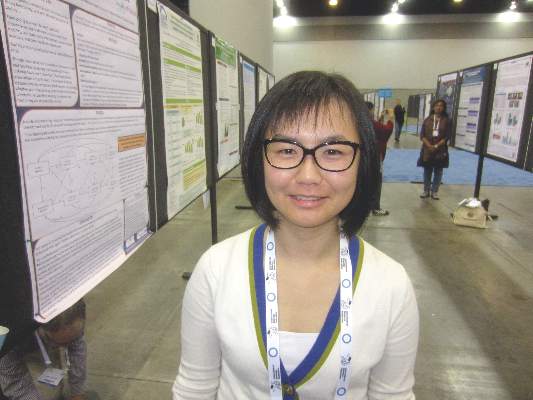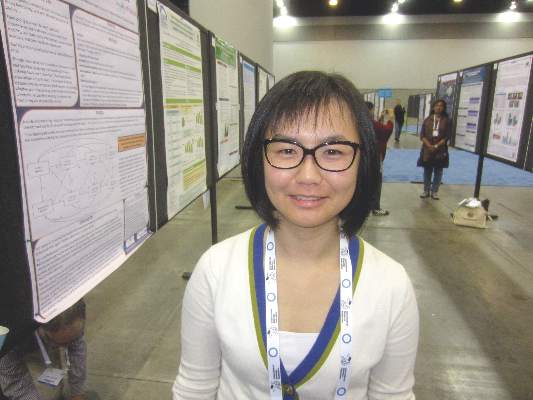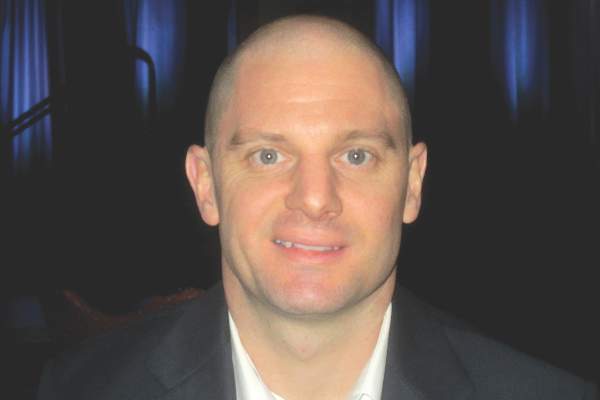User login
M. Alexander Otto began his reporting career early in 1999 covering the pharmaceutical industry for a national pharmacists' magazine and freelancing for the Washington Post and other newspapers. He then joined BNA, now part of Bloomberg News, covering health law and the protection of people and animals in medical research. Alex next worked for the McClatchy Company. Based on his work, Alex won a year-long Knight Science Journalism Fellowship to MIT in 2008-2009. He joined the company shortly thereafter. Alex has a newspaper journalism degree from Syracuse (N.Y.) University and a master's degree in medical science -- a physician assistant degree -- from George Washington University. Alex is based in Seattle.
Simple change increases forced-air warming use in trauma
SAN ANTONIO – A month-long quality improvement project to increase the use of forced-air warming blankets reduced mean hypothermia times in trauma patients at Parkland Memorial Hospital, Dallas, from 229 to 154 minutes.
All it took to get doctors, nurses, and staff to use the forced-air warming blankets more often was a reminder that hypothermia is an independent predictor of death in trauma, and data showing that Parkland, a Level 1 trauma center, used forced-air warming in just 11% of its hypothermic trauma patients. Meetings to get those points across were held in December 2014.
Forced-air warming jumped to 70% of hypothermic patients over the next 4 months in 2015 (P equal to or less than .0001), leading to the 33% drop in rewarming times (P = .009). The improvement came without any shift in the use of the rewarming methods trauma teams were in the habit of using: warm blankets, room air, and IV fluids.
Investigator Dr. Frank Zhao thinks it’s something all trauma centers can and should do. “There’s no reason that we shouldn’t recommend this be part of the rewarming protocol in every trauma center. It took about a month to roll this out so everyone was on the same page and was easily achieved,” said Dr. Zhao, formerly a Parkland surgery resident but now a trauma and surgical critical care fellow at the Oregon Health and Sciences University in Portland.
The blankets are an almost universal presence in operating rooms to keep core temperatures at least 36 degrees Celsius, but “from what I’ve seen at multiple institutions, the Bair Hugger is probably one of the least used warming methods” in trauma. “They’re recommended for trauma rewarming, but we [didn’t] use them very often.” Staff were not in the habit, he said at the Eastern Association for the Surgery of Trauma scientific assembly.
From July to November 2014, before the intervention, 15.2% (114) of Levels 1 and 2 trauma patients arrived at Parkland hypothermic, versus 20.9% (82) during the colder period of January-April 2015. Almost 80% of the trauma patients over that time were male, and the average patient age was about 40 years.
The investigators have no disclosures, and there was no outside funding for the project.
SAN ANTONIO – A month-long quality improvement project to increase the use of forced-air warming blankets reduced mean hypothermia times in trauma patients at Parkland Memorial Hospital, Dallas, from 229 to 154 minutes.
All it took to get doctors, nurses, and staff to use the forced-air warming blankets more often was a reminder that hypothermia is an independent predictor of death in trauma, and data showing that Parkland, a Level 1 trauma center, used forced-air warming in just 11% of its hypothermic trauma patients. Meetings to get those points across were held in December 2014.
Forced-air warming jumped to 70% of hypothermic patients over the next 4 months in 2015 (P equal to or less than .0001), leading to the 33% drop in rewarming times (P = .009). The improvement came without any shift in the use of the rewarming methods trauma teams were in the habit of using: warm blankets, room air, and IV fluids.
Investigator Dr. Frank Zhao thinks it’s something all trauma centers can and should do. “There’s no reason that we shouldn’t recommend this be part of the rewarming protocol in every trauma center. It took about a month to roll this out so everyone was on the same page and was easily achieved,” said Dr. Zhao, formerly a Parkland surgery resident but now a trauma and surgical critical care fellow at the Oregon Health and Sciences University in Portland.
The blankets are an almost universal presence in operating rooms to keep core temperatures at least 36 degrees Celsius, but “from what I’ve seen at multiple institutions, the Bair Hugger is probably one of the least used warming methods” in trauma. “They’re recommended for trauma rewarming, but we [didn’t] use them very often.” Staff were not in the habit, he said at the Eastern Association for the Surgery of Trauma scientific assembly.
From July to November 2014, before the intervention, 15.2% (114) of Levels 1 and 2 trauma patients arrived at Parkland hypothermic, versus 20.9% (82) during the colder period of January-April 2015. Almost 80% of the trauma patients over that time were male, and the average patient age was about 40 years.
The investigators have no disclosures, and there was no outside funding for the project.
SAN ANTONIO – A month-long quality improvement project to increase the use of forced-air warming blankets reduced mean hypothermia times in trauma patients at Parkland Memorial Hospital, Dallas, from 229 to 154 minutes.
All it took to get doctors, nurses, and staff to use the forced-air warming blankets more often was a reminder that hypothermia is an independent predictor of death in trauma, and data showing that Parkland, a Level 1 trauma center, used forced-air warming in just 11% of its hypothermic trauma patients. Meetings to get those points across were held in December 2014.
Forced-air warming jumped to 70% of hypothermic patients over the next 4 months in 2015 (P equal to or less than .0001), leading to the 33% drop in rewarming times (P = .009). The improvement came without any shift in the use of the rewarming methods trauma teams were in the habit of using: warm blankets, room air, and IV fluids.
Investigator Dr. Frank Zhao thinks it’s something all trauma centers can and should do. “There’s no reason that we shouldn’t recommend this be part of the rewarming protocol in every trauma center. It took about a month to roll this out so everyone was on the same page and was easily achieved,” said Dr. Zhao, formerly a Parkland surgery resident but now a trauma and surgical critical care fellow at the Oregon Health and Sciences University in Portland.
The blankets are an almost universal presence in operating rooms to keep core temperatures at least 36 degrees Celsius, but “from what I’ve seen at multiple institutions, the Bair Hugger is probably one of the least used warming methods” in trauma. “They’re recommended for trauma rewarming, but we [didn’t] use them very often.” Staff were not in the habit, he said at the Eastern Association for the Surgery of Trauma scientific assembly.
From July to November 2014, before the intervention, 15.2% (114) of Levels 1 and 2 trauma patients arrived at Parkland hypothermic, versus 20.9% (82) during the colder period of January-April 2015. Almost 80% of the trauma patients over that time were male, and the average patient age was about 40 years.
The investigators have no disclosures, and there was no outside funding for the project.
AT THE EAST SCIENTIFIC ASSEMBLY
Key clinical point: It can take as little as a month to make forced-air warming blankets a routine part of hypothermia care in trauma.
Major finding: A month-long quality improvement project to increase the use of forced-air warming blankets reduced mean hypothermia times at a Level 1 trauma center from 229 to 154 minutes.
Data source: The project involved 196 hypothermic trauma patients
Disclosures: The investigators have no disclosures, and there was no outside funding for the project.
Baux cut-points predict geriatric burn outcomes
SAN ANTONIO – Geriatric burn patients have less than a 50% chance of returning home with a Baux score of about 85, and the risk of death begins to climb steadily after a score 93, approaching 50% at 110 points and almost 100% at 130 points, according to a review of 8,001 elderly patients in the National Burn Repository.
The investigators are developing the findings into a decision-making tool to help counsel families and caregivers about their options when elderly loved ones are seriously burned.
“There’s just not a lot of data out there on prognosis after burn injury in the geriatric population. We thought a simple decision aid for discussion with key stakeholders would provide significant assistance,” said investigator Dr. Erica Hodgman, a surgery research resident at the University of Texas Southwestern Medical Center, Dallas.
The hope is that families and caregivers will be able to better judge if the patient would want to press on with treatment given the odds of returning home, being discharged to a skilled nursing or rehab facility, or dying. “I think it will help people” feel less guilty if they decide to withdraw care or not send patients far away to a burn center, she said at the Eastern Association for the Surgery of Trauma scientific assembly.
The Baux score, a well-known metric in the burn community, adds the patient’s age to the percentage of surface area burned, so a 70 year old patient burned over 23% of their body, for instance, would have a score of 93. A modified Baux score adds points for inhalation injuries, but because the data didn’t include inhalation injury severity, the investigators found it more useful to stick with the original formula.
They queried the repository for patients 65 years or older with second- or third-degree burns from 2002-2011. They excluded patients with a length of stay of a day or less, along with elective admissions, non-burn injuries, and transfers to other burn centers. Next, they calculated Baux scores for each of their 8,001 subjects and noted if the patients were discharged home or to an alternate facility, or if he or she died.
Most patients had moderate scores of 70-100, and almost half were sent home. Of the 1,509 that died in hospital, 264 (17.5%) had care withdraw at a median of 3 days, but a range of 0-231 days. Flames were the most common cause of injury, followed by scalding.
A receiver operating curve analysis found that a Baux score at or below 86.15 predicted discharge home (AUC 0.698, 75.28% sensitivity, 54.64% specificity); a score above 77.12 predicted discharge to an alternate setting (AUC 0.539, 74.91% sensitivity, 34.38% specificity); and a score above 93.3 predicted mortality (AUC 0.779, 57.46% sensitivity, 87.08% specificity).
Dr. Hodgman said she thinks the cut-points will remain useful even as burn care improves with new grafting techniques that require smaller donor sites. Such innovation will apply mostly to moderately injured patients; for the more severely injured, the predictive power of the findings should still hold.
The investigators have no disclosures.
SAN ANTONIO – Geriatric burn patients have less than a 50% chance of returning home with a Baux score of about 85, and the risk of death begins to climb steadily after a score 93, approaching 50% at 110 points and almost 100% at 130 points, according to a review of 8,001 elderly patients in the National Burn Repository.
The investigators are developing the findings into a decision-making tool to help counsel families and caregivers about their options when elderly loved ones are seriously burned.
“There’s just not a lot of data out there on prognosis after burn injury in the geriatric population. We thought a simple decision aid for discussion with key stakeholders would provide significant assistance,” said investigator Dr. Erica Hodgman, a surgery research resident at the University of Texas Southwestern Medical Center, Dallas.
The hope is that families and caregivers will be able to better judge if the patient would want to press on with treatment given the odds of returning home, being discharged to a skilled nursing or rehab facility, or dying. “I think it will help people” feel less guilty if they decide to withdraw care or not send patients far away to a burn center, she said at the Eastern Association for the Surgery of Trauma scientific assembly.
The Baux score, a well-known metric in the burn community, adds the patient’s age to the percentage of surface area burned, so a 70 year old patient burned over 23% of their body, for instance, would have a score of 93. A modified Baux score adds points for inhalation injuries, but because the data didn’t include inhalation injury severity, the investigators found it more useful to stick with the original formula.
They queried the repository for patients 65 years or older with second- or third-degree burns from 2002-2011. They excluded patients with a length of stay of a day or less, along with elective admissions, non-burn injuries, and transfers to other burn centers. Next, they calculated Baux scores for each of their 8,001 subjects and noted if the patients were discharged home or to an alternate facility, or if he or she died.
Most patients had moderate scores of 70-100, and almost half were sent home. Of the 1,509 that died in hospital, 264 (17.5%) had care withdraw at a median of 3 days, but a range of 0-231 days. Flames were the most common cause of injury, followed by scalding.
A receiver operating curve analysis found that a Baux score at or below 86.15 predicted discharge home (AUC 0.698, 75.28% sensitivity, 54.64% specificity); a score above 77.12 predicted discharge to an alternate setting (AUC 0.539, 74.91% sensitivity, 34.38% specificity); and a score above 93.3 predicted mortality (AUC 0.779, 57.46% sensitivity, 87.08% specificity).
Dr. Hodgman said she thinks the cut-points will remain useful even as burn care improves with new grafting techniques that require smaller donor sites. Such innovation will apply mostly to moderately injured patients; for the more severely injured, the predictive power of the findings should still hold.
The investigators have no disclosures.
SAN ANTONIO – Geriatric burn patients have less than a 50% chance of returning home with a Baux score of about 85, and the risk of death begins to climb steadily after a score 93, approaching 50% at 110 points and almost 100% at 130 points, according to a review of 8,001 elderly patients in the National Burn Repository.
The investigators are developing the findings into a decision-making tool to help counsel families and caregivers about their options when elderly loved ones are seriously burned.
“There’s just not a lot of data out there on prognosis after burn injury in the geriatric population. We thought a simple decision aid for discussion with key stakeholders would provide significant assistance,” said investigator Dr. Erica Hodgman, a surgery research resident at the University of Texas Southwestern Medical Center, Dallas.
The hope is that families and caregivers will be able to better judge if the patient would want to press on with treatment given the odds of returning home, being discharged to a skilled nursing or rehab facility, or dying. “I think it will help people” feel less guilty if they decide to withdraw care or not send patients far away to a burn center, she said at the Eastern Association for the Surgery of Trauma scientific assembly.
The Baux score, a well-known metric in the burn community, adds the patient’s age to the percentage of surface area burned, so a 70 year old patient burned over 23% of their body, for instance, would have a score of 93. A modified Baux score adds points for inhalation injuries, but because the data didn’t include inhalation injury severity, the investigators found it more useful to stick with the original formula.
They queried the repository for patients 65 years or older with second- or third-degree burns from 2002-2011. They excluded patients with a length of stay of a day or less, along with elective admissions, non-burn injuries, and transfers to other burn centers. Next, they calculated Baux scores for each of their 8,001 subjects and noted if the patients were discharged home or to an alternate facility, or if he or she died.
Most patients had moderate scores of 70-100, and almost half were sent home. Of the 1,509 that died in hospital, 264 (17.5%) had care withdraw at a median of 3 days, but a range of 0-231 days. Flames were the most common cause of injury, followed by scalding.
A receiver operating curve analysis found that a Baux score at or below 86.15 predicted discharge home (AUC 0.698, 75.28% sensitivity, 54.64% specificity); a score above 77.12 predicted discharge to an alternate setting (AUC 0.539, 74.91% sensitivity, 34.38% specificity); and a score above 93.3 predicted mortality (AUC 0.779, 57.46% sensitivity, 87.08% specificity).
Dr. Hodgman said she thinks the cut-points will remain useful even as burn care improves with new grafting techniques that require smaller donor sites. Such innovation will apply mostly to moderately injured patients; for the more severely injured, the predictive power of the findings should still hold.
The investigators have no disclosures.
AT THE EAST SCIENTIFIC ASSEMBLY
Key clinical point: Baux score cut-points help counsel families about their options when an elderly family member is seriously burned.
Major finding: Geriatric burn patients have less than a 50% chance of returning home with a Baux score of about 85, and the risk of death begins to climb steadily after a score 93.
Data source: Review of 8,001 patients over 65 years old in the National Burn Repository
Disclosures: The investigators have no disclosures.
Early severe-injury DCL fascial closure more likely with postop hypertonic saline
SAN ANTONIO – In massively transfused patients undergoing damage control laparotomy, postop hypertonic saline improves primary fascial closure rates at first take-back, according to investigators from the University of Texas Health Science Center at Houston.
After controlling for age, injury severity, and resuscitation volumes, primary fascial closure (PFC) at first take-back was almost four times as likely in patients who received hypertonic saline (HTS) after bleeding damage control laparotomy (DCL) instead of traditional isotonic maintenance fluids (odds ratio, 3.82; 95% confidence interval, 1.02-14.31; P = .047).
“In a group of seriously injured bleeding trauma patients undergoing DCL, the use of HTS was associated with a lower fluid balance and a higher rate of PFC at the first take-back,” the investigators concluded.
It’s unclear if the results are because of the hypertonic saline drawing off more edema fluid and making early PFC more likely, or because HTS patients in the study received less fluid than their standard maintenance peers – 30 cc/hr of 3% sodium chloride versus 125 cc/hr of traditional isotonic fluids post op.
PFC at first take-back is known to reduce complications. Previous studies have shown that HTS improves PFC rates, but they included moderately injured patients who would have been closed early no matter what postop fluids they received. The investigators wanted to see how well HTS worked in more severely injured patients.
The study compared 54 adult DCL patients from 2010 to 2011 who received traditional isotonic postop maintenance with 41 from 2013 to 2014 on HTS, both for 72 hours or until fascial closure, whichever came first. The university switched to HTS around 2012 based on earlier studies, allowing for the comparison. Patients in both groups received at least three RBC units during surgery, according to investigator Dr. Lindley Folkerson, a surgery resident at the university.
Twenty-seven HTS patients (66%) were closed at first take-back, versus 33 (61%) in the traditional maintenance group. The median time for closure was 29 hours in the HTS group but 38 hours in traditional maintenance patients (P = .035).
There were no between-group demographic or injury severity differences, but because the university has become more conservative with DCL in recent years, the HTS patients were more hypotensive and had greater baseline fluid deficits at emergency department arrival, and received more blood in the operating room. Even so, HTS patients had significantly lower fluid balances at 24 and 48 hours.
The university hasn’t noticed increased kidney injuries with lower-volume HTS, but that might prove to be a problem in a larger study, Dr. Folkerson said at the annual scientific assembly of the Eastern Association for the Surgery of Trauma.
A limitation of the study is that patients were resuscitated as their physicians saw fit, so some in the HTS group likely got isotonic fluids. “We did not restrict fluids because they were on the HTS protocol. Crystalloid, colloid, and blood products were given as deemed necessary by the bedside physician,” she said.
The investigators had no disclosures.
We all agree that fascial closure should be a goal. Many people have many ideas on how best to achieve delayed primary fascial closure. Diuretics decrease visceral edema. The Whitman patch prevents fascial retraction. Patients who return earlier to the operating room are more likely to be closed.
This study describes an institutional effort to improve rates of delayed primary fascial closure which should be commended. Despite patients presenting more critically ill, the rate of closure at first take-back was improved with hypertonic saline. Maybe it is not the hypertonic saline per se but the fact that they gave it instead of all the fluid we used to give.
Dr. Margaret Lauerman is an assistant professor of shock trauma at the University of Maryland Medical Center in Baltimore. She has no disclosures.
We all agree that fascial closure should be a goal. Many people have many ideas on how best to achieve delayed primary fascial closure. Diuretics decrease visceral edema. The Whitman patch prevents fascial retraction. Patients who return earlier to the operating room are more likely to be closed.
This study describes an institutional effort to improve rates of delayed primary fascial closure which should be commended. Despite patients presenting more critically ill, the rate of closure at first take-back was improved with hypertonic saline. Maybe it is not the hypertonic saline per se but the fact that they gave it instead of all the fluid we used to give.
Dr. Margaret Lauerman is an assistant professor of shock trauma at the University of Maryland Medical Center in Baltimore. She has no disclosures.
We all agree that fascial closure should be a goal. Many people have many ideas on how best to achieve delayed primary fascial closure. Diuretics decrease visceral edema. The Whitman patch prevents fascial retraction. Patients who return earlier to the operating room are more likely to be closed.
This study describes an institutional effort to improve rates of delayed primary fascial closure which should be commended. Despite patients presenting more critically ill, the rate of closure at first take-back was improved with hypertonic saline. Maybe it is not the hypertonic saline per se but the fact that they gave it instead of all the fluid we used to give.
Dr. Margaret Lauerman is an assistant professor of shock trauma at the University of Maryland Medical Center in Baltimore. She has no disclosures.
SAN ANTONIO – In massively transfused patients undergoing damage control laparotomy, postop hypertonic saline improves primary fascial closure rates at first take-back, according to investigators from the University of Texas Health Science Center at Houston.
After controlling for age, injury severity, and resuscitation volumes, primary fascial closure (PFC) at first take-back was almost four times as likely in patients who received hypertonic saline (HTS) after bleeding damage control laparotomy (DCL) instead of traditional isotonic maintenance fluids (odds ratio, 3.82; 95% confidence interval, 1.02-14.31; P = .047).
“In a group of seriously injured bleeding trauma patients undergoing DCL, the use of HTS was associated with a lower fluid balance and a higher rate of PFC at the first take-back,” the investigators concluded.
It’s unclear if the results are because of the hypertonic saline drawing off more edema fluid and making early PFC more likely, or because HTS patients in the study received less fluid than their standard maintenance peers – 30 cc/hr of 3% sodium chloride versus 125 cc/hr of traditional isotonic fluids post op.
PFC at first take-back is known to reduce complications. Previous studies have shown that HTS improves PFC rates, but they included moderately injured patients who would have been closed early no matter what postop fluids they received. The investigators wanted to see how well HTS worked in more severely injured patients.
The study compared 54 adult DCL patients from 2010 to 2011 who received traditional isotonic postop maintenance with 41 from 2013 to 2014 on HTS, both for 72 hours or until fascial closure, whichever came first. The university switched to HTS around 2012 based on earlier studies, allowing for the comparison. Patients in both groups received at least three RBC units during surgery, according to investigator Dr. Lindley Folkerson, a surgery resident at the university.
Twenty-seven HTS patients (66%) were closed at first take-back, versus 33 (61%) in the traditional maintenance group. The median time for closure was 29 hours in the HTS group but 38 hours in traditional maintenance patients (P = .035).
There were no between-group demographic or injury severity differences, but because the university has become more conservative with DCL in recent years, the HTS patients were more hypotensive and had greater baseline fluid deficits at emergency department arrival, and received more blood in the operating room. Even so, HTS patients had significantly lower fluid balances at 24 and 48 hours.
The university hasn’t noticed increased kidney injuries with lower-volume HTS, but that might prove to be a problem in a larger study, Dr. Folkerson said at the annual scientific assembly of the Eastern Association for the Surgery of Trauma.
A limitation of the study is that patients were resuscitated as their physicians saw fit, so some in the HTS group likely got isotonic fluids. “We did not restrict fluids because they were on the HTS protocol. Crystalloid, colloid, and blood products were given as deemed necessary by the bedside physician,” she said.
The investigators had no disclosures.
SAN ANTONIO – In massively transfused patients undergoing damage control laparotomy, postop hypertonic saline improves primary fascial closure rates at first take-back, according to investigators from the University of Texas Health Science Center at Houston.
After controlling for age, injury severity, and resuscitation volumes, primary fascial closure (PFC) at first take-back was almost four times as likely in patients who received hypertonic saline (HTS) after bleeding damage control laparotomy (DCL) instead of traditional isotonic maintenance fluids (odds ratio, 3.82; 95% confidence interval, 1.02-14.31; P = .047).
“In a group of seriously injured bleeding trauma patients undergoing DCL, the use of HTS was associated with a lower fluid balance and a higher rate of PFC at the first take-back,” the investigators concluded.
It’s unclear if the results are because of the hypertonic saline drawing off more edema fluid and making early PFC more likely, or because HTS patients in the study received less fluid than their standard maintenance peers – 30 cc/hr of 3% sodium chloride versus 125 cc/hr of traditional isotonic fluids post op.
PFC at first take-back is known to reduce complications. Previous studies have shown that HTS improves PFC rates, but they included moderately injured patients who would have been closed early no matter what postop fluids they received. The investigators wanted to see how well HTS worked in more severely injured patients.
The study compared 54 adult DCL patients from 2010 to 2011 who received traditional isotonic postop maintenance with 41 from 2013 to 2014 on HTS, both for 72 hours or until fascial closure, whichever came first. The university switched to HTS around 2012 based on earlier studies, allowing for the comparison. Patients in both groups received at least three RBC units during surgery, according to investigator Dr. Lindley Folkerson, a surgery resident at the university.
Twenty-seven HTS patients (66%) were closed at first take-back, versus 33 (61%) in the traditional maintenance group. The median time for closure was 29 hours in the HTS group but 38 hours in traditional maintenance patients (P = .035).
There were no between-group demographic or injury severity differences, but because the university has become more conservative with DCL in recent years, the HTS patients were more hypotensive and had greater baseline fluid deficits at emergency department arrival, and received more blood in the operating room. Even so, HTS patients had significantly lower fluid balances at 24 and 48 hours.
The university hasn’t noticed increased kidney injuries with lower-volume HTS, but that might prove to be a problem in a larger study, Dr. Folkerson said at the annual scientific assembly of the Eastern Association for the Surgery of Trauma.
A limitation of the study is that patients were resuscitated as their physicians saw fit, so some in the HTS group likely got isotonic fluids. “We did not restrict fluids because they were on the HTS protocol. Crystalloid, colloid, and blood products were given as deemed necessary by the bedside physician,” she said.
The investigators had no disclosures.
AT THE EAST SCIENTIFIC ASSEMBLY
Key clinical point: Order 30 cc/hour of 3% sodium chloride after bleeding DCL if you want to close patients in about a day.
Major finding: The median time for fascial closure was 29 hours in the hypertonic saline. group but 38 hours in the traditional fluid maintenance group (P = .035).
Data source: Review of 95 DCL patients.
Disclosures: The investigators had no disclosures.
Limit antibiotics to 4 days for percutaneous abdominal infection drainage
SAN ANTONIO – Four days of antibiotics is sufficient and safe for percutaneous drainage of complicated intra-abdominal infections in non-ICU patients, according to investigators from the University of Miami.
“There was no difference in outcome between a shorter and longer duration of antimicrobial therapy in those with percutaneously drained source control of a CIAI [complicated intra-abdominal infection]. Percutaneously drained intra-abdominal infections do not require longer duration of antimicrobial therapy,” they concluded.
The findings are from a posthoc subgroup analysis of the influential STOP-IT [Study to Optimize Peritoneal Infection Therapy] trial, which found that in CIAI patients with adequate source control, “the outcomes after fixed-duration antibiotic therapy (approximately 4 days) were similar to those after a longer course of antibiotics (approximately 7 days) that extended until after the resolution of physiological abnormalities” (N Engl J Med. 2015 May 21;372[21]:1996-2005).
STOP-IT lumped together patients who had both surgical and percutaneous source control. Unlike surgical clean out, percutaneous drainage usually leaves behind some infection; the Miami investigators wanted to see if that made a difference in the safety and effectiveness of short-course antibiotics. Seventy-two patients received a 4-day course and 57 were on antibiotics until 2 days after their symptoms resolved, which usually worked out to about 7 days.
There were no statistically significant differences between the groups in the rates of recurrent intra-abdominal infection (9.7% in the 4-day group vs. 10.5% in the longer-duration group, P = 1.00), Clostridium difficile infection (0% vs. 1.8%; P = .442), and hospital days (a mean of 4 days in both). The only difference was that the time to recurrent infection was shorter in the 4-day group (12.7 vs. 21.3 days; P = .015). None of the patients died.
The big caveat with STOP-IT and the posthoc analysis is that the patients weren’t very sick. Their mean APACHE [Acute Physiology and Chronic Health Evaluation] score was 10, and fevers and leukocytosis were generally mild. Patients without adequate source control, patients with open abdomens, and those likely to die within 72 hours were excluded.
“They were very different from our patients in the ICU with major complex intra-abdominal infections and septic shock and multiorgan dysfunction. To take STOP-IT or our analysis and say we are going to extrapolate that to our sickest patients and stop their antibiotics at 4 days is dangerous without further study. That’s the population everyone’s asking about now. We need a larger [randomized, controlled trial] in a much sicker population” to know how to handle the issue, said posthoc investigator Dr. Rishi Rattan, a critical care and trauma surgery fellow at the University of Miami.
The other big question, as raised by an audience member, and one at the other end of the spectrum is if antibiotics are needed at all after adequate source control, at least in some patients.
“We should look at that. I think we need to push the envelope and drill down even further to 48 and 24 hours, and study that versus 4 days,” Dr. Rattan said at the Eastern Association for the Surgery of Trauma scientific assembly.
Patients in STOP-IT were aged 16 years and older with either a temperature of at least 38º C, white blood cell counts of 11,000 cells/mm3 or higher, or peritonitis-induced gastrointestinal dysfunction. Baseline demographics, comorbidities, and illness severity were similar between treatment arms. Appendicitis was limited to about 10% of infections, so there was a diversity of infections and heterogeneity in the study population. Antibiotic selection was empiric, based on investigators’ institutions.
Based on STOP-IT, the University of Miami now usually limits antibiotics to 4 days after source control of CIAI in less-sick patients. The University was a STOP-IT site, which is why the posthoc team had access to the data.
The investigators have no disclosures.
This project is an important one. We hit [complicated intra-abdominal infection patients] hard and fast, and they do better, but when do we stop?
We all know that we give antibiotics for too long and to the wrong patients, and that this isn’t for free. Increased costs, drug resistance, and C. difficile infections result. But like training wheels and crutches, it’s hard to know when to give them up. The authors tackled this question, but patients without adequate source control were excluded and the study was underpowered. We know shorter courses of antibiotics are probably the right thing, but how do we prove it?
Dr. Jennifer Knight is an acute care surgeon at the West Virginia University in Morgantown. She has no disclosures.
This project is an important one. We hit [complicated intra-abdominal infection patients] hard and fast, and they do better, but when do we stop?
We all know that we give antibiotics for too long and to the wrong patients, and that this isn’t for free. Increased costs, drug resistance, and C. difficile infections result. But like training wheels and crutches, it’s hard to know when to give them up. The authors tackled this question, but patients without adequate source control were excluded and the study was underpowered. We know shorter courses of antibiotics are probably the right thing, but how do we prove it?
Dr. Jennifer Knight is an acute care surgeon at the West Virginia University in Morgantown. She has no disclosures.
This project is an important one. We hit [complicated intra-abdominal infection patients] hard and fast, and they do better, but when do we stop?
We all know that we give antibiotics for too long and to the wrong patients, and that this isn’t for free. Increased costs, drug resistance, and C. difficile infections result. But like training wheels and crutches, it’s hard to know when to give them up. The authors tackled this question, but patients without adequate source control were excluded and the study was underpowered. We know shorter courses of antibiotics are probably the right thing, but how do we prove it?
Dr. Jennifer Knight is an acute care surgeon at the West Virginia University in Morgantown. She has no disclosures.
SAN ANTONIO – Four days of antibiotics is sufficient and safe for percutaneous drainage of complicated intra-abdominal infections in non-ICU patients, according to investigators from the University of Miami.
“There was no difference in outcome between a shorter and longer duration of antimicrobial therapy in those with percutaneously drained source control of a CIAI [complicated intra-abdominal infection]. Percutaneously drained intra-abdominal infections do not require longer duration of antimicrobial therapy,” they concluded.
The findings are from a posthoc subgroup analysis of the influential STOP-IT [Study to Optimize Peritoneal Infection Therapy] trial, which found that in CIAI patients with adequate source control, “the outcomes after fixed-duration antibiotic therapy (approximately 4 days) were similar to those after a longer course of antibiotics (approximately 7 days) that extended until after the resolution of physiological abnormalities” (N Engl J Med. 2015 May 21;372[21]:1996-2005).
STOP-IT lumped together patients who had both surgical and percutaneous source control. Unlike surgical clean out, percutaneous drainage usually leaves behind some infection; the Miami investigators wanted to see if that made a difference in the safety and effectiveness of short-course antibiotics. Seventy-two patients received a 4-day course and 57 were on antibiotics until 2 days after their symptoms resolved, which usually worked out to about 7 days.
There were no statistically significant differences between the groups in the rates of recurrent intra-abdominal infection (9.7% in the 4-day group vs. 10.5% in the longer-duration group, P = 1.00), Clostridium difficile infection (0% vs. 1.8%; P = .442), and hospital days (a mean of 4 days in both). The only difference was that the time to recurrent infection was shorter in the 4-day group (12.7 vs. 21.3 days; P = .015). None of the patients died.
The big caveat with STOP-IT and the posthoc analysis is that the patients weren’t very sick. Their mean APACHE [Acute Physiology and Chronic Health Evaluation] score was 10, and fevers and leukocytosis were generally mild. Patients without adequate source control, patients with open abdomens, and those likely to die within 72 hours were excluded.
“They were very different from our patients in the ICU with major complex intra-abdominal infections and septic shock and multiorgan dysfunction. To take STOP-IT or our analysis and say we are going to extrapolate that to our sickest patients and stop their antibiotics at 4 days is dangerous without further study. That’s the population everyone’s asking about now. We need a larger [randomized, controlled trial] in a much sicker population” to know how to handle the issue, said posthoc investigator Dr. Rishi Rattan, a critical care and trauma surgery fellow at the University of Miami.
The other big question, as raised by an audience member, and one at the other end of the spectrum is if antibiotics are needed at all after adequate source control, at least in some patients.
“We should look at that. I think we need to push the envelope and drill down even further to 48 and 24 hours, and study that versus 4 days,” Dr. Rattan said at the Eastern Association for the Surgery of Trauma scientific assembly.
Patients in STOP-IT were aged 16 years and older with either a temperature of at least 38º C, white blood cell counts of 11,000 cells/mm3 or higher, or peritonitis-induced gastrointestinal dysfunction. Baseline demographics, comorbidities, and illness severity were similar between treatment arms. Appendicitis was limited to about 10% of infections, so there was a diversity of infections and heterogeneity in the study population. Antibiotic selection was empiric, based on investigators’ institutions.
Based on STOP-IT, the University of Miami now usually limits antibiotics to 4 days after source control of CIAI in less-sick patients. The University was a STOP-IT site, which is why the posthoc team had access to the data.
The investigators have no disclosures.
SAN ANTONIO – Four days of antibiotics is sufficient and safe for percutaneous drainage of complicated intra-abdominal infections in non-ICU patients, according to investigators from the University of Miami.
“There was no difference in outcome between a shorter and longer duration of antimicrobial therapy in those with percutaneously drained source control of a CIAI [complicated intra-abdominal infection]. Percutaneously drained intra-abdominal infections do not require longer duration of antimicrobial therapy,” they concluded.
The findings are from a posthoc subgroup analysis of the influential STOP-IT [Study to Optimize Peritoneal Infection Therapy] trial, which found that in CIAI patients with adequate source control, “the outcomes after fixed-duration antibiotic therapy (approximately 4 days) were similar to those after a longer course of antibiotics (approximately 7 days) that extended until after the resolution of physiological abnormalities” (N Engl J Med. 2015 May 21;372[21]:1996-2005).
STOP-IT lumped together patients who had both surgical and percutaneous source control. Unlike surgical clean out, percutaneous drainage usually leaves behind some infection; the Miami investigators wanted to see if that made a difference in the safety and effectiveness of short-course antibiotics. Seventy-two patients received a 4-day course and 57 were on antibiotics until 2 days after their symptoms resolved, which usually worked out to about 7 days.
There were no statistically significant differences between the groups in the rates of recurrent intra-abdominal infection (9.7% in the 4-day group vs. 10.5% in the longer-duration group, P = 1.00), Clostridium difficile infection (0% vs. 1.8%; P = .442), and hospital days (a mean of 4 days in both). The only difference was that the time to recurrent infection was shorter in the 4-day group (12.7 vs. 21.3 days; P = .015). None of the patients died.
The big caveat with STOP-IT and the posthoc analysis is that the patients weren’t very sick. Their mean APACHE [Acute Physiology and Chronic Health Evaluation] score was 10, and fevers and leukocytosis were generally mild. Patients without adequate source control, patients with open abdomens, and those likely to die within 72 hours were excluded.
“They were very different from our patients in the ICU with major complex intra-abdominal infections and septic shock and multiorgan dysfunction. To take STOP-IT or our analysis and say we are going to extrapolate that to our sickest patients and stop their antibiotics at 4 days is dangerous without further study. That’s the population everyone’s asking about now. We need a larger [randomized, controlled trial] in a much sicker population” to know how to handle the issue, said posthoc investigator Dr. Rishi Rattan, a critical care and trauma surgery fellow at the University of Miami.
The other big question, as raised by an audience member, and one at the other end of the spectrum is if antibiotics are needed at all after adequate source control, at least in some patients.
“We should look at that. I think we need to push the envelope and drill down even further to 48 and 24 hours, and study that versus 4 days,” Dr. Rattan said at the Eastern Association for the Surgery of Trauma scientific assembly.
Patients in STOP-IT were aged 16 years and older with either a temperature of at least 38º C, white blood cell counts of 11,000 cells/mm3 or higher, or peritonitis-induced gastrointestinal dysfunction. Baseline demographics, comorbidities, and illness severity were similar between treatment arms. Appendicitis was limited to about 10% of infections, so there was a diversity of infections and heterogeneity in the study population. Antibiotic selection was empiric, based on investigators’ institutions.
Based on STOP-IT, the University of Miami now usually limits antibiotics to 4 days after source control of CIAI in less-sick patients. The University was a STOP-IT site, which is why the posthoc team had access to the data.
The investigators have no disclosures.
AT The EAST SCIENTIFIC ASSEMBLY
Key clinical point: For patients who aren’t too sick, a 4-day course of antibiotics is adequate for percutaneous drainage of complicated intra-abdominal infections.
Major finding: The rate of recurrent infection is the same whether patients have a 4- or 7-day course (9.7% vs. 10.5%; P = 1.00),
Data source: Posthoc analysis of 129 patients in the STOP-IT trial
Disclosures: The investigators have no disclosures.
ACR: Push back when insurance decisions force TNFi change
SAN FRANCISCO – Stopping a tumor necrosis factor inhibitor for nonmedical reasons is associated with significantly worse clinical outcomes and increased health care resource use, according to a review of 166 rheumatoid arthritis patients from the Physicians Consulting Network.
That’s probably not a surprise; the main value of the findings is that they provide ammunition to push back against insurance decisions that lead to stopping or switching tumor necrosis factor inhibitors (TNFi) that are helping patients.
After being stable on their TNFi for at least 6 months, 25 patients in the study were forced to stop their medication for a range of nonmedical economic reasons such as increased copays, change of insurance, or loss of job health insurance. Another 58 switched to a new TNFi for similar reasons. Those 83 patients were matched to 83 others who were also stable on their TNFi for at least 6 months but continued the therapy. Data came from chart reviews by rheumatologists, and all the patients were under the care of physicians participating in the Physicians Consulting Network, which provides feedback to GfK, a market research firm.
Over the next year, 48% of switchers/discontinuers were deemed to have well controlled RA by their rheumatologists, versus 84% of continuers. Switchers and discontinuers were almost 4 times as likely to flare, and more than 10 times as likely to have severe RA at the end of the year.
Switchers/discontinuers also had more inpatient days and emergency department and urgent care visits. Switchers and discontinuers had more than six times greater odds of visiting emergency departments and urgent care clinics at least once, compared with continuers. The differences were statistically significant. In short, payers may have saved on the front end, but probably lost on the back end.
“These real world data demonstrate that patients are significantly affected by switching or discontinuing their stable and effective [TNFi] therapy for rheumatoid arthritis. I don’t think there is any patient who asks to have their [TNFi] switched when they are doing well, and it would be uncommon for a rheumatologist to switch or discontinue [a TNFi] when patients are doing well. These are insurance-driven things that are impacting negatively on patient care, and this should stop. The [American College of Rheumatology] and other groups need to work together to get insurance companies to stop intervening in this way,” said investigator Dr. Douglas Wolf, medical director at Atlanta Gastroenterology Associates.
Similar problems have been reported when TNFi drugs are switched or stopped in Crohn’s disease, psoriasis, and other immunologic conditions, he said at the annual meeting of the American College of Rheumatology.
Switchers and discontinuers were more likely than were continuers to be Hispanic (27.7% vs. 15.7%; P = .041), but otherwise there were no significant differences between cohorts in baseline sociodemographic and disease characteristics, comorbidities, medication use, or resource utilization.
The investigators plan to continue the project to see if TNFi switchers fair better than discontinuers.
Dr. Wolf and other investigators disclosed relationships with AbbVie, including some who received payments from the company to participate in the research. Three authors are employees of AbbVie, maker of adalimumab (Humira).
SAN FRANCISCO – Stopping a tumor necrosis factor inhibitor for nonmedical reasons is associated with significantly worse clinical outcomes and increased health care resource use, according to a review of 166 rheumatoid arthritis patients from the Physicians Consulting Network.
That’s probably not a surprise; the main value of the findings is that they provide ammunition to push back against insurance decisions that lead to stopping or switching tumor necrosis factor inhibitors (TNFi) that are helping patients.
After being stable on their TNFi for at least 6 months, 25 patients in the study were forced to stop their medication for a range of nonmedical economic reasons such as increased copays, change of insurance, or loss of job health insurance. Another 58 switched to a new TNFi for similar reasons. Those 83 patients were matched to 83 others who were also stable on their TNFi for at least 6 months but continued the therapy. Data came from chart reviews by rheumatologists, and all the patients were under the care of physicians participating in the Physicians Consulting Network, which provides feedback to GfK, a market research firm.
Over the next year, 48% of switchers/discontinuers were deemed to have well controlled RA by their rheumatologists, versus 84% of continuers. Switchers and discontinuers were almost 4 times as likely to flare, and more than 10 times as likely to have severe RA at the end of the year.
Switchers/discontinuers also had more inpatient days and emergency department and urgent care visits. Switchers and discontinuers had more than six times greater odds of visiting emergency departments and urgent care clinics at least once, compared with continuers. The differences were statistically significant. In short, payers may have saved on the front end, but probably lost on the back end.
“These real world data demonstrate that patients are significantly affected by switching or discontinuing their stable and effective [TNFi] therapy for rheumatoid arthritis. I don’t think there is any patient who asks to have their [TNFi] switched when they are doing well, and it would be uncommon for a rheumatologist to switch or discontinue [a TNFi] when patients are doing well. These are insurance-driven things that are impacting negatively on patient care, and this should stop. The [American College of Rheumatology] and other groups need to work together to get insurance companies to stop intervening in this way,” said investigator Dr. Douglas Wolf, medical director at Atlanta Gastroenterology Associates.
Similar problems have been reported when TNFi drugs are switched or stopped in Crohn’s disease, psoriasis, and other immunologic conditions, he said at the annual meeting of the American College of Rheumatology.
Switchers and discontinuers were more likely than were continuers to be Hispanic (27.7% vs. 15.7%; P = .041), but otherwise there were no significant differences between cohorts in baseline sociodemographic and disease characteristics, comorbidities, medication use, or resource utilization.
The investigators plan to continue the project to see if TNFi switchers fair better than discontinuers.
Dr. Wolf and other investigators disclosed relationships with AbbVie, including some who received payments from the company to participate in the research. Three authors are employees of AbbVie, maker of adalimumab (Humira).
SAN FRANCISCO – Stopping a tumor necrosis factor inhibitor for nonmedical reasons is associated with significantly worse clinical outcomes and increased health care resource use, according to a review of 166 rheumatoid arthritis patients from the Physicians Consulting Network.
That’s probably not a surprise; the main value of the findings is that they provide ammunition to push back against insurance decisions that lead to stopping or switching tumor necrosis factor inhibitors (TNFi) that are helping patients.
After being stable on their TNFi for at least 6 months, 25 patients in the study were forced to stop their medication for a range of nonmedical economic reasons such as increased copays, change of insurance, or loss of job health insurance. Another 58 switched to a new TNFi for similar reasons. Those 83 patients were matched to 83 others who were also stable on their TNFi for at least 6 months but continued the therapy. Data came from chart reviews by rheumatologists, and all the patients were under the care of physicians participating in the Physicians Consulting Network, which provides feedback to GfK, a market research firm.
Over the next year, 48% of switchers/discontinuers were deemed to have well controlled RA by their rheumatologists, versus 84% of continuers. Switchers and discontinuers were almost 4 times as likely to flare, and more than 10 times as likely to have severe RA at the end of the year.
Switchers/discontinuers also had more inpatient days and emergency department and urgent care visits. Switchers and discontinuers had more than six times greater odds of visiting emergency departments and urgent care clinics at least once, compared with continuers. The differences were statistically significant. In short, payers may have saved on the front end, but probably lost on the back end.
“These real world data demonstrate that patients are significantly affected by switching or discontinuing their stable and effective [TNFi] therapy for rheumatoid arthritis. I don’t think there is any patient who asks to have their [TNFi] switched when they are doing well, and it would be uncommon for a rheumatologist to switch or discontinue [a TNFi] when patients are doing well. These are insurance-driven things that are impacting negatively on patient care, and this should stop. The [American College of Rheumatology] and other groups need to work together to get insurance companies to stop intervening in this way,” said investigator Dr. Douglas Wolf, medical director at Atlanta Gastroenterology Associates.
Similar problems have been reported when TNFi drugs are switched or stopped in Crohn’s disease, psoriasis, and other immunologic conditions, he said at the annual meeting of the American College of Rheumatology.
Switchers and discontinuers were more likely than were continuers to be Hispanic (27.7% vs. 15.7%; P = .041), but otherwise there were no significant differences between cohorts in baseline sociodemographic and disease characteristics, comorbidities, medication use, or resource utilization.
The investigators plan to continue the project to see if TNFi switchers fair better than discontinuers.
Dr. Wolf and other investigators disclosed relationships with AbbVie, including some who received payments from the company to participate in the research. Three authors are employees of AbbVie, maker of adalimumab (Humira).
AT THE ACR ANNUAL MEETING
Key clinical point: The findings provide ammunition to push back against insurance decisions that lead to stopping or switching tumor necrosis factor inhibitors (TNFi) that are helping patients.
Major finding: After a year of follow-up, 48% of switchers/discontinuers were deemed to have well controlled RA by their rheumatologists, versus 84% of continuers. Switchers and discontinuers were almost 4 times as likely to flare, and more than 10 times as likely to have severe RA at the end of the year.
Data source: Chart review of 166 RA patients.
Disclosures: The investigators disclosed relationships with AbbVie, including payments from the company to participate in the research. Three authors are employed by AbbVie, maker of adalimumab (Humira).
WDC: Resveratrol improves cerebral perfusion in type 2 diabetes
Vancouver, B.C. – Resveratrol increased cerebral blood vessel dilation in a small study of adults with type 2 diabetes mellitus, suggesting a possible role for slowing disease-related cognitive decline, according to investigators from the University of Newcastle (Australia).
Type 2 diabetes impairs the ability of blood vessels to dilate effectively in response to demand, which may impact mental performance and perhaps contribute to the greater risk of dementia in people with the disease, according to investigator Rachel Wong, Ph.D., a biomedical researcher at the university.
Her team previously demonstrated that resveratrol – a polyphenol found in berries, nuts, grapes, and, famously, red wine – improves vasodilation in the systemic circulation, so they wanted to see if would do the same in the brain (Nutr Metab Cardiovasc Dis. 2011 Nov;21(11):851-6).
Thirty-six dementia-free adults with type 2 diabetes took one of three doses of synthetic resveratrol – 75 mg, 150 mg, and 300 mg – or placebo at weekly intervals. Before and about an hour after each dose, the patients briefly breathed carbogen gas (95% oxygen, 5% carbon dioxide) to induce hypercapnia and subsequent cerebral vasodilation. Transcranial Doppler ultrasound was used to assess the change in blood flow in the middle and posterior cerebral arteries before and after dosing.
The percentage change in mean blood flow velocity in the middle cerebral arteries increased after all three doses of resveratrol, but not after placebo. The 75 and 300 mg doses both increased flow velocity by about 10%, while the 150 mg dose increased it by about 6%. Meanwhile, the 75 mg dose was the only one to increase vasodilator responsiveness in the posterior cerebral arteries.
“This is the first clinical evidence that resveratrol can enhance vasodilator responsiveness in people with type 2 diabetes. We are now investigating if regular supplementation can restore cerebral perfusion, and if that can attenuate the accelerated cognitive decline seen in this population,” Dr. Wong said.
They plan to test that with the 75 mg dose, the amount of resveratrol in about 30 liters of red wine. “I think it’s better to get it in the synthetic form,” she said.
The patients in the study were 68 years old on average, with a mean body mass index of 30 kg/m2. They had diabetes for about 10 years, and their mean hemoglobin A1c was 6.7%. The majority of subjects were on oral diabetes therapies; none of them was on insulin.
The investigators have no disclosures. The work was funded in part by the Australian National University and by DSM Nutritional Products, which provided the resveratrol.
Vancouver, B.C. – Resveratrol increased cerebral blood vessel dilation in a small study of adults with type 2 diabetes mellitus, suggesting a possible role for slowing disease-related cognitive decline, according to investigators from the University of Newcastle (Australia).
Type 2 diabetes impairs the ability of blood vessels to dilate effectively in response to demand, which may impact mental performance and perhaps contribute to the greater risk of dementia in people with the disease, according to investigator Rachel Wong, Ph.D., a biomedical researcher at the university.
Her team previously demonstrated that resveratrol – a polyphenol found in berries, nuts, grapes, and, famously, red wine – improves vasodilation in the systemic circulation, so they wanted to see if would do the same in the brain (Nutr Metab Cardiovasc Dis. 2011 Nov;21(11):851-6).
Thirty-six dementia-free adults with type 2 diabetes took one of three doses of synthetic resveratrol – 75 mg, 150 mg, and 300 mg – or placebo at weekly intervals. Before and about an hour after each dose, the patients briefly breathed carbogen gas (95% oxygen, 5% carbon dioxide) to induce hypercapnia and subsequent cerebral vasodilation. Transcranial Doppler ultrasound was used to assess the change in blood flow in the middle and posterior cerebral arteries before and after dosing.
The percentage change in mean blood flow velocity in the middle cerebral arteries increased after all three doses of resveratrol, but not after placebo. The 75 and 300 mg doses both increased flow velocity by about 10%, while the 150 mg dose increased it by about 6%. Meanwhile, the 75 mg dose was the only one to increase vasodilator responsiveness in the posterior cerebral arteries.
“This is the first clinical evidence that resveratrol can enhance vasodilator responsiveness in people with type 2 diabetes. We are now investigating if regular supplementation can restore cerebral perfusion, and if that can attenuate the accelerated cognitive decline seen in this population,” Dr. Wong said.
They plan to test that with the 75 mg dose, the amount of resveratrol in about 30 liters of red wine. “I think it’s better to get it in the synthetic form,” she said.
The patients in the study were 68 years old on average, with a mean body mass index of 30 kg/m2. They had diabetes for about 10 years, and their mean hemoglobin A1c was 6.7%. The majority of subjects were on oral diabetes therapies; none of them was on insulin.
The investigators have no disclosures. The work was funded in part by the Australian National University and by DSM Nutritional Products, which provided the resveratrol.
Vancouver, B.C. – Resveratrol increased cerebral blood vessel dilation in a small study of adults with type 2 diabetes mellitus, suggesting a possible role for slowing disease-related cognitive decline, according to investigators from the University of Newcastle (Australia).
Type 2 diabetes impairs the ability of blood vessels to dilate effectively in response to demand, which may impact mental performance and perhaps contribute to the greater risk of dementia in people with the disease, according to investigator Rachel Wong, Ph.D., a biomedical researcher at the university.
Her team previously demonstrated that resveratrol – a polyphenol found in berries, nuts, grapes, and, famously, red wine – improves vasodilation in the systemic circulation, so they wanted to see if would do the same in the brain (Nutr Metab Cardiovasc Dis. 2011 Nov;21(11):851-6).
Thirty-six dementia-free adults with type 2 diabetes took one of three doses of synthetic resveratrol – 75 mg, 150 mg, and 300 mg – or placebo at weekly intervals. Before and about an hour after each dose, the patients briefly breathed carbogen gas (95% oxygen, 5% carbon dioxide) to induce hypercapnia and subsequent cerebral vasodilation. Transcranial Doppler ultrasound was used to assess the change in blood flow in the middle and posterior cerebral arteries before and after dosing.
The percentage change in mean blood flow velocity in the middle cerebral arteries increased after all three doses of resveratrol, but not after placebo. The 75 and 300 mg doses both increased flow velocity by about 10%, while the 150 mg dose increased it by about 6%. Meanwhile, the 75 mg dose was the only one to increase vasodilator responsiveness in the posterior cerebral arteries.
“This is the first clinical evidence that resveratrol can enhance vasodilator responsiveness in people with type 2 diabetes. We are now investigating if regular supplementation can restore cerebral perfusion, and if that can attenuate the accelerated cognitive decline seen in this population,” Dr. Wong said.
They plan to test that with the 75 mg dose, the amount of resveratrol in about 30 liters of red wine. “I think it’s better to get it in the synthetic form,” she said.
The patients in the study were 68 years old on average, with a mean body mass index of 30 kg/m2. They had diabetes for about 10 years, and their mean hemoglobin A1c was 6.7%. The majority of subjects were on oral diabetes therapies; none of them was on insulin.
The investigators have no disclosures. The work was funded in part by the Australian National University and by DSM Nutritional Products, which provided the resveratrol.
AT The WORLD DIABETES CONGRESS
Key clinical point: Resveratrol is being investigated to slow cognitive decline in type 2 diabetes.
Major finding: Doses of 75 and 300 mg improved cerebral vasodilator responsiveness by about 10%.
Data source: Dose finding study in 36 type 2 diabetics.
Disclosures: The investigators have no disclosures. The work was funded in part by the Australian National University and DSM Nutritional Products, which provided the resveratrol.
Screen for and Treat Patients with Diabetes Distress
Vancouver, B.C. – Screening for “diabetes distress” should probably be a part of routine care for patients with type 2 diabetes mellitus, according to investigators from the University of British Columbia, Vancouver.
The team administered the Diabetes Distress Scale (DDS) questionnaire to 148 consecutive patients with type 2 diabetes at a university diabetes clinic; 39% scored positively for diabetes distress, as indicated by a score of 2 or more on the DDS, and stress correlated with poorer glycemic control. In particular, higher hemoglobin A1c scores correlated, although weakly, with a higher perception of emotional burden from diabetes (r2 = 0.198) and greater stress over treatment regimens (r2 = 0.249). The correlation between stress and worse glycemic control was strongest in patients with hemoglobin A1c above 9% (r2 = 0.387).
After its first appearance in the medical literature over a decade ago, diabetes distress has been shown to impact how well patients do. It’s a mix of negative emotions – for instance, frustration, anxiety, and burnout – related to the management of disease, and it’s been diagnosed in up to 43% of patients in previous studies. Diabetes distress is distinct from clinical depression. In fact, just 12% of the study subjects screened positive for depression on the Personal Health Questionnaire-9, which was administered along with the DDS,. Depression, although related to the use of insulin, had no impact on glycemic control.
“Diabetes distress, particularly emotional and self-care-related distress, is quite high in this population; I think it’s clinically important that we address it. We should be using some sort of screening for distress,” said investigator Dr. Evelyn Wong, an endocrinology fellow at the university.
Previous investigations have found that if distress is reduced, glycemic control improves. How exactly to do that is the subject of ongoing investigation, but education on self-management seems to help. Improving relationships with health care providers and helping patients find alternatives for problematic regimens might also help, Dr. Wong said at the World Diabetes Congress.
“Diabetes is a bit of a silent disease,” at least until complications emerge, “so patients may not understand why they need to take insulin, or why it’s important to bring down hemoglobin A1c. We” have to make sure they understand such issues and help them come to terms with their illness. Overall, “I think it’s the time spent with the patient that is important,” she said.
A unique finding of the Vancouver study was that patients who felt less satisfied with their providers had better glycemic control. Perhaps they had stricter physicians or were more vigilant about their diabetes because they didn’t have much faith in their physician.
The DDS is a 17 item scale that uses 6-point Likert scales to measure the emotional burden of diabetes; its impact on personal relationships; patient concerns about treatment regimens; and the quality of relationships with providers. For instance, patients are asked the degree to which a “feeling that I will end up with serious long-term complications no matter what I do” applies to them. A two-question diabetes distress screening scale is also available.
Subjects in the study were in their mid-50s on average, the majority were white, and two-thirds were men. They had type 2 diabetes for an average of 9 years; and 20% were on insulin; the mean hemoglobin A1c was 8.7%.
The investigators have no conflicts of interest.
Vancouver, B.C. – Screening for “diabetes distress” should probably be a part of routine care for patients with type 2 diabetes mellitus, according to investigators from the University of British Columbia, Vancouver.
The team administered the Diabetes Distress Scale (DDS) questionnaire to 148 consecutive patients with type 2 diabetes at a university diabetes clinic; 39% scored positively for diabetes distress, as indicated by a score of 2 or more on the DDS, and stress correlated with poorer glycemic control. In particular, higher hemoglobin A1c scores correlated, although weakly, with a higher perception of emotional burden from diabetes (r2 = 0.198) and greater stress over treatment regimens (r2 = 0.249). The correlation between stress and worse glycemic control was strongest in patients with hemoglobin A1c above 9% (r2 = 0.387).
After its first appearance in the medical literature over a decade ago, diabetes distress has been shown to impact how well patients do. It’s a mix of negative emotions – for instance, frustration, anxiety, and burnout – related to the management of disease, and it’s been diagnosed in up to 43% of patients in previous studies. Diabetes distress is distinct from clinical depression. In fact, just 12% of the study subjects screened positive for depression on the Personal Health Questionnaire-9, which was administered along with the DDS,. Depression, although related to the use of insulin, had no impact on glycemic control.
“Diabetes distress, particularly emotional and self-care-related distress, is quite high in this population; I think it’s clinically important that we address it. We should be using some sort of screening for distress,” said investigator Dr. Evelyn Wong, an endocrinology fellow at the university.
Previous investigations have found that if distress is reduced, glycemic control improves. How exactly to do that is the subject of ongoing investigation, but education on self-management seems to help. Improving relationships with health care providers and helping patients find alternatives for problematic regimens might also help, Dr. Wong said at the World Diabetes Congress.
“Diabetes is a bit of a silent disease,” at least until complications emerge, “so patients may not understand why they need to take insulin, or why it’s important to bring down hemoglobin A1c. We” have to make sure they understand such issues and help them come to terms with their illness. Overall, “I think it’s the time spent with the patient that is important,” she said.
A unique finding of the Vancouver study was that patients who felt less satisfied with their providers had better glycemic control. Perhaps they had stricter physicians or were more vigilant about their diabetes because they didn’t have much faith in their physician.
The DDS is a 17 item scale that uses 6-point Likert scales to measure the emotional burden of diabetes; its impact on personal relationships; patient concerns about treatment regimens; and the quality of relationships with providers. For instance, patients are asked the degree to which a “feeling that I will end up with serious long-term complications no matter what I do” applies to them. A two-question diabetes distress screening scale is also available.
Subjects in the study were in their mid-50s on average, the majority were white, and two-thirds were men. They had type 2 diabetes for an average of 9 years; and 20% were on insulin; the mean hemoglobin A1c was 8.7%.
The investigators have no conflicts of interest.
Vancouver, B.C. – Screening for “diabetes distress” should probably be a part of routine care for patients with type 2 diabetes mellitus, according to investigators from the University of British Columbia, Vancouver.
The team administered the Diabetes Distress Scale (DDS) questionnaire to 148 consecutive patients with type 2 diabetes at a university diabetes clinic; 39% scored positively for diabetes distress, as indicated by a score of 2 or more on the DDS, and stress correlated with poorer glycemic control. In particular, higher hemoglobin A1c scores correlated, although weakly, with a higher perception of emotional burden from diabetes (r2 = 0.198) and greater stress over treatment regimens (r2 = 0.249). The correlation between stress and worse glycemic control was strongest in patients with hemoglobin A1c above 9% (r2 = 0.387).
After its first appearance in the medical literature over a decade ago, diabetes distress has been shown to impact how well patients do. It’s a mix of negative emotions – for instance, frustration, anxiety, and burnout – related to the management of disease, and it’s been diagnosed in up to 43% of patients in previous studies. Diabetes distress is distinct from clinical depression. In fact, just 12% of the study subjects screened positive for depression on the Personal Health Questionnaire-9, which was administered along with the DDS,. Depression, although related to the use of insulin, had no impact on glycemic control.
“Diabetes distress, particularly emotional and self-care-related distress, is quite high in this population; I think it’s clinically important that we address it. We should be using some sort of screening for distress,” said investigator Dr. Evelyn Wong, an endocrinology fellow at the university.
Previous investigations have found that if distress is reduced, glycemic control improves. How exactly to do that is the subject of ongoing investigation, but education on self-management seems to help. Improving relationships with health care providers and helping patients find alternatives for problematic regimens might also help, Dr. Wong said at the World Diabetes Congress.
“Diabetes is a bit of a silent disease,” at least until complications emerge, “so patients may not understand why they need to take insulin, or why it’s important to bring down hemoglobin A1c. We” have to make sure they understand such issues and help them come to terms with their illness. Overall, “I think it’s the time spent with the patient that is important,” she said.
A unique finding of the Vancouver study was that patients who felt less satisfied with their providers had better glycemic control. Perhaps they had stricter physicians or were more vigilant about their diabetes because they didn’t have much faith in their physician.
The DDS is a 17 item scale that uses 6-point Likert scales to measure the emotional burden of diabetes; its impact on personal relationships; patient concerns about treatment regimens; and the quality of relationships with providers. For instance, patients are asked the degree to which a “feeling that I will end up with serious long-term complications no matter what I do” applies to them. A two-question diabetes distress screening scale is also available.
Subjects in the study were in their mid-50s on average, the majority were white, and two-thirds were men. They had type 2 diabetes for an average of 9 years; and 20% were on insulin; the mean hemoglobin A1c was 8.7%.
The investigators have no conflicts of interest.
AT The WORLD DIABETES CONGRESS
WDC: Screen for and treat patients with diabetes distress
Vancouver, B.C. – Screening for “diabetes distress” should probably be a part of routine care for patients with type 2 diabetes mellitus, according to investigators from the University of British Columbia, Vancouver.
The team administered the Diabetes Distress Scale (DDS) questionnaire to 148 consecutive patients with type 2 diabetes at a university diabetes clinic; 39% scored positively for diabetes distress, as indicated by a score of 2 or more on the DDS, and stress correlated with poorer glycemic control. In particular, higher hemoglobin A1c scores correlated, although weakly, with a higher perception of emotional burden from diabetes (r2 = 0.198) and greater stress over treatment regimens (r2 = 0.249). The correlation between stress and worse glycemic control was strongest in patients with hemoglobin A1c above 9% (r2 = 0.387).
After its first appearance in the medical literature over a decade ago, diabetes distress has been shown to impact how well patients do. It’s a mix of negative emotions – for instance, frustration, anxiety, and burnout – related to the management of disease, and it’s been diagnosed in up to 43% of patients in previous studies. Diabetes distress is distinct from clinical depression. In fact, just 12% of the study subjects screened positive for depression on the Personal Health Questionnaire-9, which was administered along with the DDS,. Depression, although related to the use of insulin, had no impact on glycemic control.
“Diabetes distress, particularly emotional and self-care-related distress, is quite high in this population; I think it’s clinically important that we address it. We should be using some sort of screening for distress,” said investigator Dr. Evelyn Wong, an endocrinology fellow at the university.
Previous investigations have found that if distress is reduced, glycemic control improves. How exactly to do that is the subject of ongoing investigation, but education on self-management seems to help. Improving relationships with health care providers and helping patients find alternatives for problematic regimens might also help, Dr. Wong said at the World Diabetes Congress.
“Diabetes is a bit of a silent disease,” at least until complications emerge, “so patients may not understand why they need to take insulin, or why it’s important to bring down hemoglobin A1c. We” have to make sure they understand such issues and help them come to terms with their illness. Overall, “I think it’s the time spent with the patient that is important,” she said.
A unique finding of the Vancouver study was that patients who felt less satisfied with their providers had better glycemic control. Perhaps they had stricter physicians or were more vigilant about their diabetes because they didn’t have much faith in their physician.
The DDS is a 17 item scale that uses 6-point Likert scales to measure the emotional burden of diabetes; its impact on personal relationships; patient concerns about treatment regimens; and the quality of relationships with providers. For instance, patients are asked the degree to which a “feeling that I will end up with serious long-term complications no matter what I do” applies to them. A two-question diabetes distress screening scale is also available.
Subjects in the study were in their mid-50s on average, the majority were white, and two-thirds were men. They had type 2 diabetes for an average of 9 years; and 20% were on insulin; the mean hemoglobin A1c was 8.7%.
The investigators have no conflicts of interest.
Vancouver, B.C. – Screening for “diabetes distress” should probably be a part of routine care for patients with type 2 diabetes mellitus, according to investigators from the University of British Columbia, Vancouver.
The team administered the Diabetes Distress Scale (DDS) questionnaire to 148 consecutive patients with type 2 diabetes at a university diabetes clinic; 39% scored positively for diabetes distress, as indicated by a score of 2 or more on the DDS, and stress correlated with poorer glycemic control. In particular, higher hemoglobin A1c scores correlated, although weakly, with a higher perception of emotional burden from diabetes (r2 = 0.198) and greater stress over treatment regimens (r2 = 0.249). The correlation between stress and worse glycemic control was strongest in patients with hemoglobin A1c above 9% (r2 = 0.387).
After its first appearance in the medical literature over a decade ago, diabetes distress has been shown to impact how well patients do. It’s a mix of negative emotions – for instance, frustration, anxiety, and burnout – related to the management of disease, and it’s been diagnosed in up to 43% of patients in previous studies. Diabetes distress is distinct from clinical depression. In fact, just 12% of the study subjects screened positive for depression on the Personal Health Questionnaire-9, which was administered along with the DDS,. Depression, although related to the use of insulin, had no impact on glycemic control.
“Diabetes distress, particularly emotional and self-care-related distress, is quite high in this population; I think it’s clinically important that we address it. We should be using some sort of screening for distress,” said investigator Dr. Evelyn Wong, an endocrinology fellow at the university.
Previous investigations have found that if distress is reduced, glycemic control improves. How exactly to do that is the subject of ongoing investigation, but education on self-management seems to help. Improving relationships with health care providers and helping patients find alternatives for problematic regimens might also help, Dr. Wong said at the World Diabetes Congress.
“Diabetes is a bit of a silent disease,” at least until complications emerge, “so patients may not understand why they need to take insulin, or why it’s important to bring down hemoglobin A1c. We” have to make sure they understand such issues and help them come to terms with their illness. Overall, “I think it’s the time spent with the patient that is important,” she said.
A unique finding of the Vancouver study was that patients who felt less satisfied with their providers had better glycemic control. Perhaps they had stricter physicians or were more vigilant about their diabetes because they didn’t have much faith in their physician.
The DDS is a 17 item scale that uses 6-point Likert scales to measure the emotional burden of diabetes; its impact on personal relationships; patient concerns about treatment regimens; and the quality of relationships with providers. For instance, patients are asked the degree to which a “feeling that I will end up with serious long-term complications no matter what I do” applies to them. A two-question diabetes distress screening scale is also available.
Subjects in the study were in their mid-50s on average, the majority were white, and two-thirds were men. They had type 2 diabetes for an average of 9 years; and 20% were on insulin; the mean hemoglobin A1c was 8.7%.
The investigators have no conflicts of interest.
Vancouver, B.C. – Screening for “diabetes distress” should probably be a part of routine care for patients with type 2 diabetes mellitus, according to investigators from the University of British Columbia, Vancouver.
The team administered the Diabetes Distress Scale (DDS) questionnaire to 148 consecutive patients with type 2 diabetes at a university diabetes clinic; 39% scored positively for diabetes distress, as indicated by a score of 2 or more on the DDS, and stress correlated with poorer glycemic control. In particular, higher hemoglobin A1c scores correlated, although weakly, with a higher perception of emotional burden from diabetes (r2 = 0.198) and greater stress over treatment regimens (r2 = 0.249). The correlation between stress and worse glycemic control was strongest in patients with hemoglobin A1c above 9% (r2 = 0.387).
After its first appearance in the medical literature over a decade ago, diabetes distress has been shown to impact how well patients do. It’s a mix of negative emotions – for instance, frustration, anxiety, and burnout – related to the management of disease, and it’s been diagnosed in up to 43% of patients in previous studies. Diabetes distress is distinct from clinical depression. In fact, just 12% of the study subjects screened positive for depression on the Personal Health Questionnaire-9, which was administered along with the DDS,. Depression, although related to the use of insulin, had no impact on glycemic control.
“Diabetes distress, particularly emotional and self-care-related distress, is quite high in this population; I think it’s clinically important that we address it. We should be using some sort of screening for distress,” said investigator Dr. Evelyn Wong, an endocrinology fellow at the university.
Previous investigations have found that if distress is reduced, glycemic control improves. How exactly to do that is the subject of ongoing investigation, but education on self-management seems to help. Improving relationships with health care providers and helping patients find alternatives for problematic regimens might also help, Dr. Wong said at the World Diabetes Congress.
“Diabetes is a bit of a silent disease,” at least until complications emerge, “so patients may not understand why they need to take insulin, or why it’s important to bring down hemoglobin A1c. We” have to make sure they understand such issues and help them come to terms with their illness. Overall, “I think it’s the time spent with the patient that is important,” she said.
A unique finding of the Vancouver study was that patients who felt less satisfied with their providers had better glycemic control. Perhaps they had stricter physicians or were more vigilant about their diabetes because they didn’t have much faith in their physician.
The DDS is a 17 item scale that uses 6-point Likert scales to measure the emotional burden of diabetes; its impact on personal relationships; patient concerns about treatment regimens; and the quality of relationships with providers. For instance, patients are asked the degree to which a “feeling that I will end up with serious long-term complications no matter what I do” applies to them. A two-question diabetes distress screening scale is also available.
Subjects in the study were in their mid-50s on average, the majority were white, and two-thirds were men. They had type 2 diabetes for an average of 9 years; and 20% were on insulin; the mean hemoglobin A1c was 8.7%.
The investigators have no conflicts of interest.
AT The WORLD DIABETES CONGRESS
Key clinical point: It’s becoming clear that patients do better when their stress about having diabetes is addressed.
Major finding: Among 148 patients with type 2 diabetes mellitis, 39% scored positively for diabetes distress.
Data source: Consecutive patients at a university diabetes clinic.
Disclosures: The investigators have no disclosures.
WDC: Slender patients to benefit most from new basal insulins
Vancouver, B.C. – The new, longer-acting injectable basal insulins Tresiba (insulin degludec) and Toujeo (insulin glargine U300 [300 units/mL]) will probably be most helpful for slender patients with low insulin requirements, according to Dr. Matthew C. Riddle, Jr., professor of medicine at the Oregon Health & Science University in Portland.
Longer durations of action – over 24 hours for both agents – mean lower doses of insulin and less peak and trough variation, both of which reduce the risk of hypoglycemia. Since lighter patients with low insulin requirements are most at risk for hypoglycemia, Dr. Riddle expects them to benefit most from degludec and glargine U300.
“My prediction is when daily insulin requirements are under about 25 units, there will be a clinically demonstrable difference in hypoglycemia. I think low-dose requiring slender patients” – most people with type 1 diabetes, and even some with type 2 – “should get the most benefit, but we don’t have direct proof of that yet. My guess is that maybe 25% of patients are going to see a difference with the new basal insulins,” he said.
Insulin degludec, available in 100 units/mL and 200 units/mL formulations, “is very long-acting,” 42 hours or longer, due to delayed absorption and clearance. Insulin glargine U300 uses the same molecule as insulin glargine U100 (Lantus), but it is more concentrated and absorbed more slowly. Lantus lasts about 24 hours in some patients and fewer in others. The U300 formulation lasts perhaps 30 hours (Diabetes Care. 2015 Apr;38[4]:637-43).
Meanwhile, concentrated insulins – Dr. Riddle included Humulin R U-500 on the list, but also glargine U300 and degludec U200 – might help patients with high daily insulin requirements; concentrated formulations mean fewer shots and, perhaps, greater adherence.
“Cost is the elephant in the room” with the newer insulins. “It cannot be left out of scientific meetings anymore because it drives behavior. In my community, there is a 10-fold difference between human insulins and the newer analogs. Some of our patients are going back to NPH and regular insulin,” because they cost less, he said.
Biosimilar insulins might help with the cost issue. The efficacy of the newly approved Basaglar (insulin glargine injection 100 unit/mL), for instance, was virtually indistinguishable from Lantus in testing and, at least in Europe, is slightly less expensive.
In general, “if you start insulin early, you get better results” in patients with type 2 diabetes mellitus. When patients start insulin with a hemoglobin A1c below 8%, that measure of long-term blood glucose control will drop below 7 in 75% “quickly and easily. That’s not rocket science. But, in general, we do not start insulin early. We probably should,” Dr. Riddle said.
At the end of his talk, he fielded a question about glucagon-like peptide-1 receptor agonists, a newer class of injectables for type 2 diabetes.
“In our clinic, we are still using basal insulin as the first agent 80% of the time” for type 2. “We know the safety and capability of insulins,” but “don’t have long term data” on the GLP-1 agonists, so “I don’t think that’s going to change in the short term.” In trials, the agonists were no better at glucose control than basal insulin alone, so they seem best at this point “when weight control is very important. I’d use” GLP-1 agonists and insulin “separately before using them together,” he said.
Dr. Riddle disclosed travel expenses, institutional research grants, consulting fees, or lecture honoraria from AstraZeneca, Eli Lilly, Novo Nordisk, Sanofi, and other companies.
Vancouver, B.C. – The new, longer-acting injectable basal insulins Tresiba (insulin degludec) and Toujeo (insulin glargine U300 [300 units/mL]) will probably be most helpful for slender patients with low insulin requirements, according to Dr. Matthew C. Riddle, Jr., professor of medicine at the Oregon Health & Science University in Portland.
Longer durations of action – over 24 hours for both agents – mean lower doses of insulin and less peak and trough variation, both of which reduce the risk of hypoglycemia. Since lighter patients with low insulin requirements are most at risk for hypoglycemia, Dr. Riddle expects them to benefit most from degludec and glargine U300.
“My prediction is when daily insulin requirements are under about 25 units, there will be a clinically demonstrable difference in hypoglycemia. I think low-dose requiring slender patients” – most people with type 1 diabetes, and even some with type 2 – “should get the most benefit, but we don’t have direct proof of that yet. My guess is that maybe 25% of patients are going to see a difference with the new basal insulins,” he said.
Insulin degludec, available in 100 units/mL and 200 units/mL formulations, “is very long-acting,” 42 hours or longer, due to delayed absorption and clearance. Insulin glargine U300 uses the same molecule as insulin glargine U100 (Lantus), but it is more concentrated and absorbed more slowly. Lantus lasts about 24 hours in some patients and fewer in others. The U300 formulation lasts perhaps 30 hours (Diabetes Care. 2015 Apr;38[4]:637-43).
Meanwhile, concentrated insulins – Dr. Riddle included Humulin R U-500 on the list, but also glargine U300 and degludec U200 – might help patients with high daily insulin requirements; concentrated formulations mean fewer shots and, perhaps, greater adherence.
“Cost is the elephant in the room” with the newer insulins. “It cannot be left out of scientific meetings anymore because it drives behavior. In my community, there is a 10-fold difference between human insulins and the newer analogs. Some of our patients are going back to NPH and regular insulin,” because they cost less, he said.
Biosimilar insulins might help with the cost issue. The efficacy of the newly approved Basaglar (insulin glargine injection 100 unit/mL), for instance, was virtually indistinguishable from Lantus in testing and, at least in Europe, is slightly less expensive.
In general, “if you start insulin early, you get better results” in patients with type 2 diabetes mellitus. When patients start insulin with a hemoglobin A1c below 8%, that measure of long-term blood glucose control will drop below 7 in 75% “quickly and easily. That’s not rocket science. But, in general, we do not start insulin early. We probably should,” Dr. Riddle said.
At the end of his talk, he fielded a question about glucagon-like peptide-1 receptor agonists, a newer class of injectables for type 2 diabetes.
“In our clinic, we are still using basal insulin as the first agent 80% of the time” for type 2. “We know the safety and capability of insulins,” but “don’t have long term data” on the GLP-1 agonists, so “I don’t think that’s going to change in the short term.” In trials, the agonists were no better at glucose control than basal insulin alone, so they seem best at this point “when weight control is very important. I’d use” GLP-1 agonists and insulin “separately before using them together,” he said.
Dr. Riddle disclosed travel expenses, institutional research grants, consulting fees, or lecture honoraria from AstraZeneca, Eli Lilly, Novo Nordisk, Sanofi, and other companies.
Vancouver, B.C. – The new, longer-acting injectable basal insulins Tresiba (insulin degludec) and Toujeo (insulin glargine U300 [300 units/mL]) will probably be most helpful for slender patients with low insulin requirements, according to Dr. Matthew C. Riddle, Jr., professor of medicine at the Oregon Health & Science University in Portland.
Longer durations of action – over 24 hours for both agents – mean lower doses of insulin and less peak and trough variation, both of which reduce the risk of hypoglycemia. Since lighter patients with low insulin requirements are most at risk for hypoglycemia, Dr. Riddle expects them to benefit most from degludec and glargine U300.
“My prediction is when daily insulin requirements are under about 25 units, there will be a clinically demonstrable difference in hypoglycemia. I think low-dose requiring slender patients” – most people with type 1 diabetes, and even some with type 2 – “should get the most benefit, but we don’t have direct proof of that yet. My guess is that maybe 25% of patients are going to see a difference with the new basal insulins,” he said.
Insulin degludec, available in 100 units/mL and 200 units/mL formulations, “is very long-acting,” 42 hours or longer, due to delayed absorption and clearance. Insulin glargine U300 uses the same molecule as insulin glargine U100 (Lantus), but it is more concentrated and absorbed more slowly. Lantus lasts about 24 hours in some patients and fewer in others. The U300 formulation lasts perhaps 30 hours (Diabetes Care. 2015 Apr;38[4]:637-43).
Meanwhile, concentrated insulins – Dr. Riddle included Humulin R U-500 on the list, but also glargine U300 and degludec U200 – might help patients with high daily insulin requirements; concentrated formulations mean fewer shots and, perhaps, greater adherence.
“Cost is the elephant in the room” with the newer insulins. “It cannot be left out of scientific meetings anymore because it drives behavior. In my community, there is a 10-fold difference between human insulins and the newer analogs. Some of our patients are going back to NPH and regular insulin,” because they cost less, he said.
Biosimilar insulins might help with the cost issue. The efficacy of the newly approved Basaglar (insulin glargine injection 100 unit/mL), for instance, was virtually indistinguishable from Lantus in testing and, at least in Europe, is slightly less expensive.
In general, “if you start insulin early, you get better results” in patients with type 2 diabetes mellitus. When patients start insulin with a hemoglobin A1c below 8%, that measure of long-term blood glucose control will drop below 7 in 75% “quickly and easily. That’s not rocket science. But, in general, we do not start insulin early. We probably should,” Dr. Riddle said.
At the end of his talk, he fielded a question about glucagon-like peptide-1 receptor agonists, a newer class of injectables for type 2 diabetes.
“In our clinic, we are still using basal insulin as the first agent 80% of the time” for type 2. “We know the safety and capability of insulins,” but “don’t have long term data” on the GLP-1 agonists, so “I don’t think that’s going to change in the short term.” In trials, the agonists were no better at glucose control than basal insulin alone, so they seem best at this point “when weight control is very important. I’d use” GLP-1 agonists and insulin “separately before using them together,” he said.
Dr. Riddle disclosed travel expenses, institutional research grants, consulting fees, or lecture honoraria from AstraZeneca, Eli Lilly, Novo Nordisk, Sanofi, and other companies.
EXPERT ANALYSIS FROM The WORLD DIABETES CONGRESS
No benefit in open massage over closed compressions in trauma cardiac arrest
SAN ANTONIO – Open-chest cardiac massage offers no benefit over closed-chest compressions in patients with traumatic cardiac arrest, according to a prospective observational study from the University of Maryland Shock Trauma Center in Baltimore.
The investigators compared 16 open-chest cardiac massage (OCCM) patients with 17 closed-chest compression (CCC) patients delivered directly to the level 1 trauma center in cardiac arrest. The open-massage group received closed compressions for a mean of 66 seconds before being converted to open massage for reasons that weren’t captured by the data.
End-tidal carbon dioxide (ETCO2) – the gold standard for determining the effectiveness of chest compressions and return of spontaneous circulation – was used as a surrogate for cardiac output and adequacy of resuscitation. Continuous high-resolution ETCO2 measurements were collected every 6 seconds in both groups.
When periods of OCCM were compared to equivalent periods of CCC, there were no differences in the initial, final, peak, or mean ETCO2 values, and there was no difference in return of spontaneous circulation (OCCM, 23.5% versus CCC, 38.9%; P = .53).
“Unless the patient has a thoracic injury that you need to get into the chest to fix, we didn’t see any benefit in opening the chest just to massage the heart. The data suggest that maybe we shouldn’t be so aggressive in doing open cardiac massage. There’s renewed interest in performing endovascular balloon occlusion techniques for the aorta to obtain hemorrhage control; if you do that and you do closed-chest compressions, it’s just as effective as opening up the chest and doing cardiac massage,” said investigator Dr. Matthew Bradley, a trauma surgeon at the Shock Trauma Center, at the annual scientific assembly of the Eastern Association for the Surgery of Trauma.
Most of the patients were men, and there was a higher percentage of penetrating trauma in the OCCM group (81% versus 47%; P = .04).
The results were the same, however, in subgroup analyses limited to blunt and penetrating trauma.
All of the open massage patients died, but there were a few survivors in the CCC group. Dr. Bradley didn’t think the closed versus open approach was the reason for the survival difference.
Resuscitative endovascular balloon occlusion of the aorta patients were excluded from the trial to prevent confounding.
The investigators have no relevant disclosures.
SAN ANTONIO – Open-chest cardiac massage offers no benefit over closed-chest compressions in patients with traumatic cardiac arrest, according to a prospective observational study from the University of Maryland Shock Trauma Center in Baltimore.
The investigators compared 16 open-chest cardiac massage (OCCM) patients with 17 closed-chest compression (CCC) patients delivered directly to the level 1 trauma center in cardiac arrest. The open-massage group received closed compressions for a mean of 66 seconds before being converted to open massage for reasons that weren’t captured by the data.
End-tidal carbon dioxide (ETCO2) – the gold standard for determining the effectiveness of chest compressions and return of spontaneous circulation – was used as a surrogate for cardiac output and adequacy of resuscitation. Continuous high-resolution ETCO2 measurements were collected every 6 seconds in both groups.
When periods of OCCM were compared to equivalent periods of CCC, there were no differences in the initial, final, peak, or mean ETCO2 values, and there was no difference in return of spontaneous circulation (OCCM, 23.5% versus CCC, 38.9%; P = .53).
“Unless the patient has a thoracic injury that you need to get into the chest to fix, we didn’t see any benefit in opening the chest just to massage the heart. The data suggest that maybe we shouldn’t be so aggressive in doing open cardiac massage. There’s renewed interest in performing endovascular balloon occlusion techniques for the aorta to obtain hemorrhage control; if you do that and you do closed-chest compressions, it’s just as effective as opening up the chest and doing cardiac massage,” said investigator Dr. Matthew Bradley, a trauma surgeon at the Shock Trauma Center, at the annual scientific assembly of the Eastern Association for the Surgery of Trauma.
Most of the patients were men, and there was a higher percentage of penetrating trauma in the OCCM group (81% versus 47%; P = .04).
The results were the same, however, in subgroup analyses limited to blunt and penetrating trauma.
All of the open massage patients died, but there were a few survivors in the CCC group. Dr. Bradley didn’t think the closed versus open approach was the reason for the survival difference.
Resuscitative endovascular balloon occlusion of the aorta patients were excluded from the trial to prevent confounding.
The investigators have no relevant disclosures.
SAN ANTONIO – Open-chest cardiac massage offers no benefit over closed-chest compressions in patients with traumatic cardiac arrest, according to a prospective observational study from the University of Maryland Shock Trauma Center in Baltimore.
The investigators compared 16 open-chest cardiac massage (OCCM) patients with 17 closed-chest compression (CCC) patients delivered directly to the level 1 trauma center in cardiac arrest. The open-massage group received closed compressions for a mean of 66 seconds before being converted to open massage for reasons that weren’t captured by the data.
End-tidal carbon dioxide (ETCO2) – the gold standard for determining the effectiveness of chest compressions and return of spontaneous circulation – was used as a surrogate for cardiac output and adequacy of resuscitation. Continuous high-resolution ETCO2 measurements were collected every 6 seconds in both groups.
When periods of OCCM were compared to equivalent periods of CCC, there were no differences in the initial, final, peak, or mean ETCO2 values, and there was no difference in return of spontaneous circulation (OCCM, 23.5% versus CCC, 38.9%; P = .53).
“Unless the patient has a thoracic injury that you need to get into the chest to fix, we didn’t see any benefit in opening the chest just to massage the heart. The data suggest that maybe we shouldn’t be so aggressive in doing open cardiac massage. There’s renewed interest in performing endovascular balloon occlusion techniques for the aorta to obtain hemorrhage control; if you do that and you do closed-chest compressions, it’s just as effective as opening up the chest and doing cardiac massage,” said investigator Dr. Matthew Bradley, a trauma surgeon at the Shock Trauma Center, at the annual scientific assembly of the Eastern Association for the Surgery of Trauma.
Most of the patients were men, and there was a higher percentage of penetrating trauma in the OCCM group (81% versus 47%; P = .04).
The results were the same, however, in subgroup analyses limited to blunt and penetrating trauma.
All of the open massage patients died, but there were a few survivors in the CCC group. Dr. Bradley didn’t think the closed versus open approach was the reason for the survival difference.
Resuscitative endovascular balloon occlusion of the aorta patients were excluded from the trial to prevent confounding.
The investigators have no relevant disclosures.
AT THE EAST SCIENTIFIC ASSEMBLY
Key clinical point: There’s no benefit in opening the chest just to massage the heart.
Major finding: When periods of OCCM were compared to equivalent periods of CCC, there were no differences in initial, final, peak, or mean ETCO2 values, and there was no difference in return of spontaneous circulation (OCCM, 23.5% versus CCC, 38.9%; P = .53).
Data source: Prospective observational study in 33 patients
Disclosures: The investigators have no relevant disclosures.
